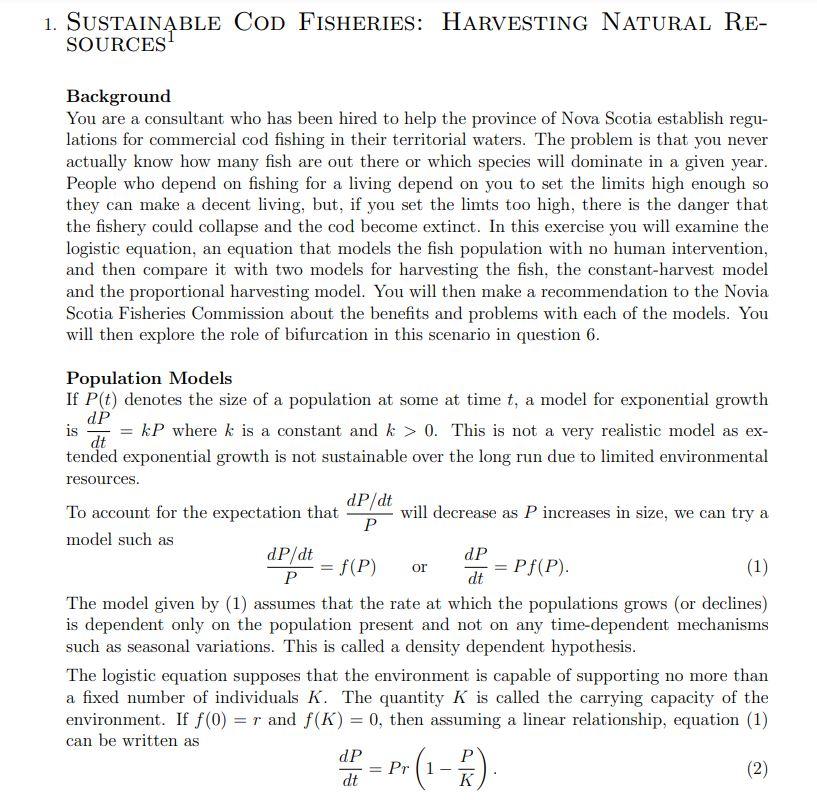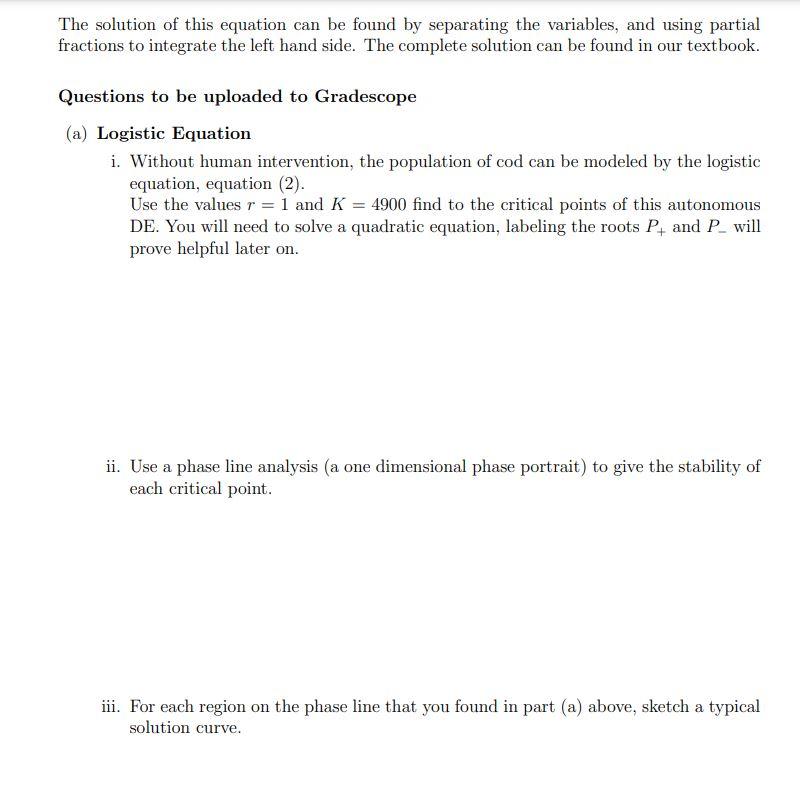Answered step by step
Verified Expert Solution
Question
1 Approved Answer
All questions of part A please. Background You are a consultant who has been hired to help the province of Nova Scotia establish regulations for


All questions of part A please.
Background You are a consultant who has been hired to help the province of Nova Scotia establish regulations for commercial cod fishing in their territorial waters. The problem is that you never actually know how many fish are out there or which species will dominate in a given year. People who depend on fishing for a living depend on you to set the limits high enough so they can make a decent living, but, if you set the limts too high, there is the danger that the fishery could collapse and the cod become extinct. In this exercise you will examine the logistic equation, an equation that models the fish population with no human intervention, and then compare it with two models for harvesting the fish, the constant-harvest model and the proportional harvesting model. You will then make a recommendation to the Novia Scotia Fisheries Commission about the benefits and problems with each of the models. You will then explore the role of bifurcation in this scenario in question 6. Population Models If P(t) denotes the size of a population at some at time t, a model for exponential growth is dtdP=kP where k is a constant and k>0. This is not a very realistic model as extended exponential growth is not sustainable over the long run due to limited environmental resources. To account for the expectation that PdP/dt will decrease as P increases in size, we can try a model such as PdP/dt=f(P)ordtdP=Pf(P). The model given by (1) assumes that the rate at which the populations grows (or declines) is dependent only on the population present and not on any time-dependent mechanisms such as seasonal variations. This is called a density dependent hypothesis. The logistic equation supposes that the environment is capable of supporting no more than a fixed number of individuals K. The quantity K is called the carrying capacity of the environment. If f(0)=r and f(K)=0, then assuming a linear relationship, equation (1) can be written as dtdP=Pr(1KP) The solution of this equation can be found by separating the variables, and using partial fractions to integrate the left hand side. The complete solution can be found in our textbook. Questions to be uploaded to Gradescope (a) Logistic Equation i. Without human intervention, the population of cod can be modeled by the logistic equation, equation (2). Use the values r=1 and K=4900 find to the critical points of this autonomous DE. You will need to solve a quadratic equation, labeling the roots P+and Pwill prove helpful later on. ii. Use a phase line analysis (a one dimensional phase portrait) to give the stability of each critical point. iii. For each region on the phase line that you found in part (a) above, sketch a typical solution curve. Background You are a consultant who has been hired to help the province of Nova Scotia establish regulations for commercial cod fishing in their territorial waters. The problem is that you never actually know how many fish are out there or which species will dominate in a given year. People who depend on fishing for a living depend on you to set the limits high enough so they can make a decent living, but, if you set the limts too high, there is the danger that the fishery could collapse and the cod become extinct. In this exercise you will examine the logistic equation, an equation that models the fish population with no human intervention, and then compare it with two models for harvesting the fish, the constant-harvest model and the proportional harvesting model. You will then make a recommendation to the Novia Scotia Fisheries Commission about the benefits and problems with each of the models. You will then explore the role of bifurcation in this scenario in question 6. Population Models If P(t) denotes the size of a population at some at time t, a model for exponential growth is dtdP=kP where k is a constant and k>0. This is not a very realistic model as extended exponential growth is not sustainable over the long run due to limited environmental resources. To account for the expectation that PdP/dt will decrease as P increases in size, we can try a model such as PdP/dt=f(P)ordtdP=Pf(P). The model given by (1) assumes that the rate at which the populations grows (or declines) is dependent only on the population present and not on any time-dependent mechanisms such as seasonal variations. This is called a density dependent hypothesis. The logistic equation supposes that the environment is capable of supporting no more than a fixed number of individuals K. The quantity K is called the carrying capacity of the environment. If f(0)=r and f(K)=0, then assuming a linear relationship, equation (1) can be written as dtdP=Pr(1KP) The solution of this equation can be found by separating the variables, and using partial fractions to integrate the left hand side. The complete solution can be found in our textbook. Questions to be uploaded to Gradescope (a) Logistic Equation i. Without human intervention, the population of cod can be modeled by the logistic equation, equation (2). Use the values r=1 and K=4900 find to the critical points of this autonomous DE. You will need to solve a quadratic equation, labeling the roots P+and Pwill prove helpful later on. ii. Use a phase line analysis (a one dimensional phase portrait) to give the stability of each critical point. iii. For each region on the phase line that you found in part (a) above, sketch a typical solution curveStep by Step Solution
There are 3 Steps involved in it
Step: 1

Get Instant Access to Expert-Tailored Solutions
See step-by-step solutions with expert insights and AI powered tools for academic success
Step: 2

Step: 3

Ace Your Homework with AI
Get the answers you need in no time with our AI-driven, step-by-step assistance
Get Started


